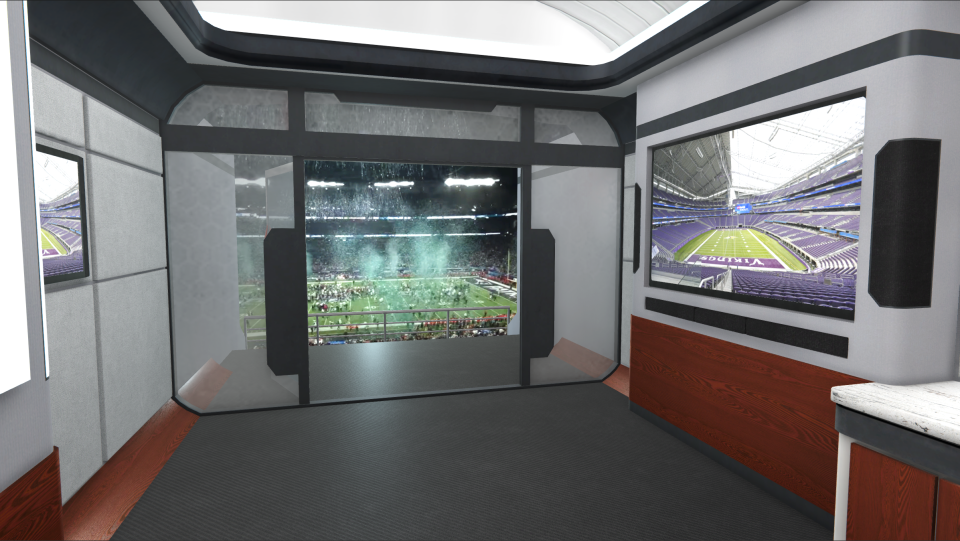Verizon streamed Super Bowl LII in VR over 5G
And almost nobody got to see it.
A crowd of more than 67,000 people watched the Philadelphia Eagles trounce the New England Patriots last Sunday at U.S. Bank Stadium in Minneapolis, while around 103 million viewers across the country did the same on their television sets. At the same time, a small group of Verizon employees in New York City were viewing the game in a different way: through VR. And they were able to do so entirely over a 5G connection.
It was all part of an ambitious 5G stress test that Verizon quietly ran during Super Bowl LII, and according to the company, it was a success. "This latest demonstration at Super Bowl LII and in New York City is another example of how we're pushing 5G to exploit never-before-imagined use cases and applications," said Sanyogita Shamsunder, Verizon's executive director of 5G ecosystems and innovation.
The work started in late November, when engineers and support staff first installed equipment in the stadium's Verizon suite. The equipment was configured to use the 800MHz bandwidth on Verizon's 28GHz millimeter wave spectrum (that's the spectrum needed for 5G).
In December, enVRmnt, a Verizon AR/VR brand, positioned two BlackMagic 4K URSA cameras in the seats below the suite. Verizon then spent the next few weeks installing even more equipment and running a couple of preliminary tests during Vikings home games, to make sure everything was set up correctly.

All of that work culminated during the Super Bowl itself, as a crew of 20 or so employees and network partners gathered together in a Verizon Open Innovation Center in the Chelsea neighborhood of New York City. Instead of watching the game on big-screen TVs, they took turns donning a single Daydream headset equipped with a Samsung Galaxy S8.
The GS8 was running a custom VR environment that placed the viewers in a replica of the aforementioned Verizon suite in Minneapolis, complete with bar and fridge. On the surrounding walls were three virtual televisions: two with 1080p resolution and one with 720p. Two of them displayed live broadcasts sourced from NBC and the NFL, while the other served up replays and highlight reels.
The real kicker of the experience, however, was that if you walked over to the end of the suite, you could watch actual live gameplay streamed directly from those aforementioned BlackMagic URSA cameras. In short, you'd be able to watch the game in full 180-degree stereoscopic view and pretend as if you were really there.
Of course, live VR streaming of sports has been done before. The NBA has been broadcasting its games in both NextVR and Intel's True VR for several months now. Intel has also partnered with the MLB to broadcast live baseball games in VR since June. But those systems still need a pretty decent home broadband connection and, according to Shamsunder, the quality just isn't as good as the one in Verizon's Super Bowl stunt. "We had 4K video being streamed into the headset on 5G. And it was live," she said. "That's something that cannot be supported on today's networks."
5G is more than just about a massive bandwidth pipe; it's also about low latency. Verizon showed this off in a separate 5G test last week, where two professional football players wore a helmet cam plus a pair of first-person goggles and were then told to throw a ball back and forth to each other. "If there's any latency at all, the football would have hit their face," said Shamsunder.
But as much as Verizon has been busy running these 5G stress tests, the carrier has so far only trialed residential 5G networks in the wild, with a plan to roll out an official version in Sacramento later this year. Rival AT&T, on the other hand, has already been busy deploying mobile 5G in test cities. It's planning an official rollout in 12 municipalities in late 2018 and could very well beat Verizon in the race to be first to dive into 5G.
Still, this VR test at the Super Bowl isn't just for show; there are real world applications. "The test is on the same spectrum as the actual specifications," said Shamsunder. "It's one capability we want to test early on and capture lessons learned so we could bring in more partners, and bring in more technology providers."
"This 28GHz millimeter wave spectrum makes us able to get several gigabits per second throughput, and the low latency opens up quick response times," she continued. "There are so many more applications and services that you can build with these capabilities."
Unfortunately, as the test was a limited one with just a select number of Verizon-affiliated employees, we really have no idea on how sharp the VR over 5G experiment was. Even if it was pretty smooth, this is, after all, just a single test. Still, we're always up for more ways to avoid missing the game while loading up on snacks.




